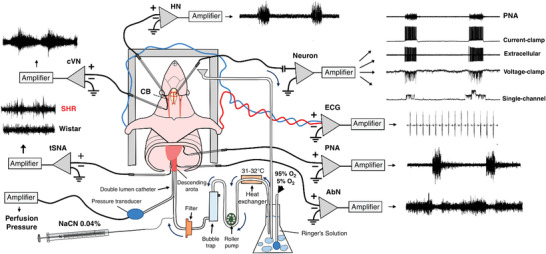Figure 1. The WHBP.

Schematic representation of the working heart–brainstem preparation, illustrating multiple respiratory and sympathetic nerves that can be recorded simultaneously using bipolar suction electrodes. Note the preparation has an open circulation allowing perfusate to be re‐circulated using a roller pump. Perfusate (Ringer plus oncotic agent) is carbogenated, warmed to 31°C, filtered (25 mm pore nylon mesh) and bubbles removed in Perspex traps prior to delivery via a double lumen catheter placed into the descending aorta for retrograde perfusion; perfusion pressure is measure at the tip of this catheter from the second lumen. See Supporting information for drawings of all apparatus for the WHBP. This catheter has a side port for administration of drugs; shown here is potassium cyanide to activate peripheral chemoreceptors. A neuromuscular blocking agent is added to the perfusate to prevent respiratory‐related movement. Using a ventral exposure, extracellular and/or patch pipettes can be placed into the medulla oblongata for single neuron recording. Notable landmarks such as hypoglossal rootlets, trapezoid body and arteries allow accurate positioning of electrodes into the brain. It is possible to remove cytoplasm for single cell qRT‐PCR. Abbreviations: AbN, abdominal nerve; cVN, cervical vagus nerve; KCN, potassium cyanide; PN, phrenic nerve; tSN, thoracic sympathetic nerve.
